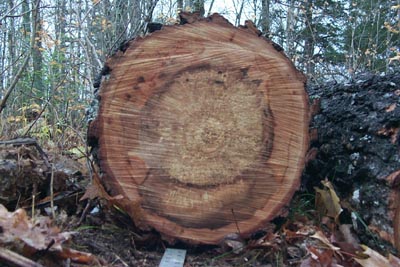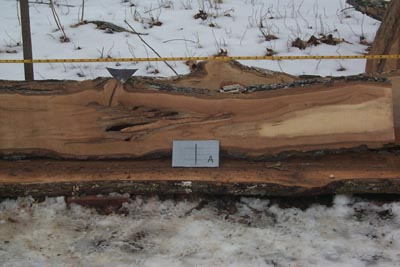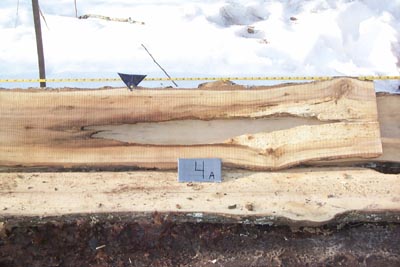
| Home |
| Tutorial |
| Photo Gallery |
| List of Defects |
| Links |
| Bark Distortion |
| Bird Peck |
| Bumps |
| Burls |
| Butt Scars |
| Butt Swells |
| Cankers |
| Conks |
| Epicormic Branches |
| Flanges |
| Flutes |
| Forks |
| Galls |
| Holes |
| Knots |
| Lesions |
| Limbs |
| Ring Shake |
| Rot |
| Seams |
| Soak |
| Splits |
| Wounds |
 e the wood of low-density species has a softer texture and higher moisture content.
e the wood of low-density species has a softer texture and higher moisture content.
There is no particular relationship between rot and tree species; rot occurs in any hardwood tree where an entry court for bacteria and fungi is available, such as insect attack or one of several sources of mechanical injury. Rot is most frequently located in the interior of the tree, specifically, the heart center.
The large number of rots occurring in the center of the tree are commonly called heart rots. The victim is the heartwood, which provides the strength to maintain the tree in its normal, upright position. The heartwood also provides various darker colors which add to the value of many woods for decorative purposes. Another prominent location of rot is the outer ring of wood, the living portion of the tree; this wood is normally characterized by very light color and is called sapwood. The rots in this location are called sap rots.
Significance: The significance of rot varies with location, stage, and use. In both log scaling and manufacturing, rot in the early stages is less consistently recognized and allowed to slip by more often than advanced rot. Rot adversely affects all classes of logs because, even if it does not qualify as a log grade defect, it reduces the potential product recovery from the log and causes a comparable loss in value. 
In veneer logs, early-stage rot is admitted if it is confined to a one-quarter segment of one end. When occurring on both ends, it must be confined to the same one-quarter segment in logs 12 to 15 inches (30.5 and 38.1 cm) in d.i.b; it can be in different one-quarter segments in logs 16 inches (40.6 cm) and larger in d.i.b. Advanced rot is admitted to a central core around the geometric center of the log and confined to the last 2 feet (61 cm) of length-subject to a scaling deduction. After the scaling deduction, logs 12 to 14 inches (30.5 to 35.6 cm) in d.i.b. can contain a central core of 3 inches (7.6 cm); logs 15 inches (38.1 cm) can contain a core of 4 inches (10.2); and logs 16 inches (40.6 cm) and larger can contain a core of 6 inches (15.2 cm). Logs with center rot cause difficulties in chucking for peeling. However, large logs (18 inches (45.7 cm) and larger in d.i.b.) of veneer class that have no more than the heart center (40 percent of d.i.b.) in rot or hollow are suited for flitching and slicing into fancy veneer.
In factory logs, all rot confined to the heart center can be overlooked as a log grade defect, but a log-scale deduction must be made for the affected section. Even though a scale deduction is made for rot, rotten areas in the quality zone are log grade defects if they occupy over one-half the cross-sectional areas in any quarter segment of the quality zone.
In construction logs smaller than 16 inches (40.6 cm) in d.i.b., rot in the heart center eliminates the log from this class. Rot in the periphery also is a degrader unless it extends only into the included tie or timber in a few minor spots and is never more than 3 inches (7.6 cm) deep. In large logs with center rot or hollow, construction lumber products (small dimension timbers, blocking, and sound square-edge planking) can be cut from the sound outer portions.
In standing trees, an estimate of the rot present must be made before the timber cruiser can adequately estimate volume, determine grade, and appraise value. Location, stage, and extent of rot and product use provide the bases for these calculations. Rot can be located on the surface or the interior of the trees. Rot has been discussed in the section on butt scar, butt and stem bulges, cankers, conks, seams, and wounds. These indicators and other signs such as vigor and crown condition also reveal the stage of rot.

